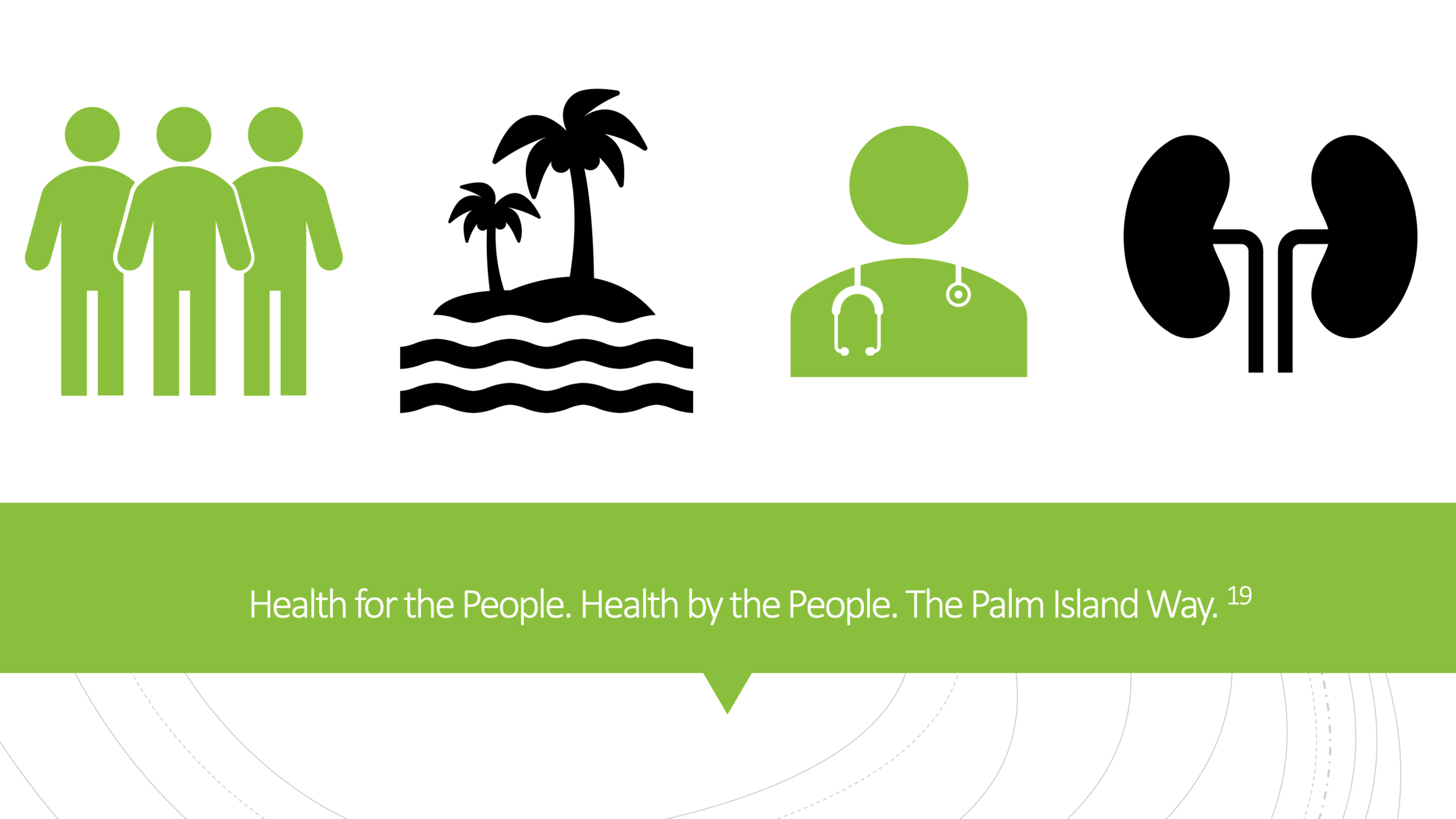Clinical Management of End-Stage Renal Disease — Palm Island, Australia.
Part 4 of 4 on Palm Island, Queensland, Australia
This chapter will focus on the management of end-stage renal disease on Palm Island, Queensland, Australia. The slides were written by Brielle Daly.
Introduction
In 2017, the healthcare staff made a commitment to turn the tide of the impact of chronic Kidney disease and to provide the Indigenous community in Palm Island with the tools they need to take ownership of their kidney health.
Palm Island is a tropical island situated 65km northwest of Townsville in Far North Queensland. It is classified as remote Australia, being RA4 and has an MMM of class 7. Prevalent health issues in the Palm Island community include: Diabetes, chronic kidney disease and cardiac disease.
The traditional owners of Palm Island are the Manbarra people. In 1914 Palm island became an Aboriginal reserve, after a cyclone destroyed the Hull River Mission. Its inhabitants were relocated to Palm Island and this period of aboriginal repression included a rigid work regime, police brutality and a removal of their traditional practices. A local described that ‘their people were to be seen but not heard.’ Many of today’s community members are descendants of Aboriginal and Torres Strait islander people who were forcibly removed to the island.
64.7% are classified in the Working age population (15-64 years). The unemployment rate is 29.5% (comparably high to the rest of Australia). The median equivalised total household income (weekly) ($) - $456, compared to Australia’s $877. This restricts people’s ability to purchase fresh fruit and vegetables – resulting in poor diets usually high in sodium – which is another risk factor for CKD. 24.4% of Palm Islanders have completed year 12 or equivalent. There are two schools available on the island and the Barrier Reef Institute of TAFE.
As of 2017, Palm Island had a population of 2613. 50.2% males and 49.8% Female. 32% of the Palm Island population are 14 years or younger. Median Age Males = 24.7. Median age Female = 25.4
Aboriginal and Torres Strait Islander people make up 94% of the population in Palm Island (2016), this is significant as the incidence of end stage renal disease for indigenous people in remote areas of Australia is 18 – 20 times higher than non-indigenous Australians.
Aboriginal and Torres Strait Islander people are more than 4 times as likely as non-indigenous people to have indicators of stages 4-5 of CKD. An increasing diabetes prevalence and chronic disease among the population, particularly in Northern Queensland, have placed renal services under intense demand and capacity pressure. Kidney Disease is known as a ‘silent condition’ as 90% of kidney function can be lost without any symptoms. Increased rates of CKD have increased the demand for palliative care services in the community.
End-stage kidney disease is a major health concern on the island. With few precipitating symptoms, it can be difficult for people to accept their diagnosis ‘because they do not feel any different or see any changes.’ And by the time they do, the patient can be in end-stage renal failure. A high prevalence of Diabetes coupled with an unhealthy diet are major risk factors for CKD. 1 in 3 people with diabetes will end up with some form of kidney damage. The local grocery store has limited fruit and vegetables available; ‘so people are going to choose the packet of chips and the bottle of coke, rather than the same expensive fruit they always have.’
Chronic Kidney Disease (CKD) occurs when evidence of reduced kidney function lasts at least 3 months, due to the nephrons which filter blood becoming damaged. The most severe form of CKD is end-stage kidney disease (ESKD).
Dialysis or a kidney transplant is required when patients are in end-stage Kidney failure. 90% of their kidney function is generally lost, and they have a GFR of <15. There are 5 stages of Chronic kidney Disease and the 5th stage indicates the patient is in end-stage renal failure. This prognosis can be determined by GFR and Albuminuria categories as shown on the screen. The detection of albumin in your urine above the normal range of 30mg/g can suggest the presence of Kidney disease, even if your GRF is above 60.
Dialysis aims to remove waste products from your blood when the kidneys begin to fail. Blood travels through a filter dialyser before returning to your body. Prior to the commencement of dialysis, vascular access is made, to form a fistula or graft. This enables two needles to be inserted during dialysis — one to take the blood from the body and the other to return it. This is not performed on Palm Island and Initial treatment for ESKD is commenced in Townsville. Peritoneal Dialysis (home) is available (no patients currently on treatment).
Renal Dialysis is delivered at the Joyce Palmer Health centre in the Satellite haemodialysis unit. The unit was refurbished in 2015 – allowing more patients with end-stage renal failure to dialyse and live locally with their families. The unit has 4 chairs which supports patients who dialyse tri-weekly.
Additional services available include:
A chronic disease outreach team, renal nurses at the unit, a monthly visiting Chronic kidney disease team – inclusive of a dietician, diabetes team and nephrologist. Most appointments require a referral from a doctor; however, some clinics will accept self-referrals and walk in patients. General practitioner – Yearly, a 715-health check is conducted which screens for risk factors of Chronic Kidney disease. Patients are given a T-shirt as an incentive to attend.
In severe weather events, it is vital to ensure that all people on dialysis are sent to the mainland, however Coordinating patient transfers can be costly and timely. Critical patients are stabilised and transferred by the Royal Flying Doctors Service (RFDS). There is a gap in palliative care services for people with ESRD. A palliative care team can help patients understand and decide whether or not to go on dialysis or cease treatment and oversee pain and symptom management. Currently, as people become unable to live at home, they are admitted as a long-term admission to the hospital, where they become palliative and remain there until end of life. This is fairly sad for the patient and their family; however, many are thankful that they can be kept on the island.
A small community allows positive relationships to be formed. Resultingly, ‘People listen and pay more attention to what health professionals are saying. ‘It’s not just another white person telling them to quit smoking, eat healthy and stop drinking.’ Visiting chronic kidney disease team. Dedicated Renal nurse’s to co-ordinate care and patient education.
Staffing in the satellite Haemodialysis unit is low (3 staff members). Decreased access to healthy food in the supermarket. Health beliefs in the community (understanding that preventive health checks are important, even if you feel physically well). Demand for palliative health care services in the community.
Prevent the onset or progression of CKD:
- Health Promotion in the community (education services, importance of regular health checks)
- Diabetic patients should monitor blood glucose levels and stay within their targets
- Formation of positive relationships between health care staff and members of the community (increases trust, adherence)
- Lead an active, healthy lifestyle and maintain a healthy weight (community health programs, exercise clubs)
Address health priorities and social determinants of health as outlined in the Palm Island Action Plan (2018-2028)
Address workforce shortages
• Increase the number of Aboriginal and Torres Strait Islander health employees
• Offer health traineeships and succession planning for the Aboriginal and Torres Strait Islander workforce in Palm Island
Establish local market gardens in Palm Island
• Implement a policy to sell locally grown and manufactured food i.e. bread, locally grown vegetables and fruit
Build positive relationships between health staff and the community
• Understand the cultural context of the community
• “It won’t just be another white person telling people to quit smoking, eat healthy and stop drinking”
- Burden of other chronic diseases and poor diet contribute to high rates
Health care delivery in Palm Island focuses on Health for the People. Health by the People. The Palm Island Way. This commitment to their community will allow for the providence of best practice medical and patient-centered care to be delivered in the future.
Published 15th May 2019. Last reviewed 30th December 2021.
Reference
1. Service-Area-Map [image]. Alliance Rehabilitation. https://alliancerehab.com.au/contact/service-area-map/. Accessed March 18, 2019.
2. Indigenous Language Map [image]. Cathy Freeman Foundation. https://www.cathyfreemanfoundation.org.au/communities. Accessed March 18, 2019.
3. Palm Island [image]. Google Maps. https://www.google.com/maps/@-18.6722653,146.5668938,11.17z. Updated 2019. Accessed March 18, 2019.
4. Australian Government Department of Health. Australia Bureau of Statistics remoteness classifications. Doctor Connect. http://www.doctorconnect.gov.au/internet/otd/publishing.nsf/Content/locator. Published 2015. Accessed March 18, 2019.
5. Australian Government Department of Health. Custom Remoteness Classification. Doctor Connect. http://www.doctorconnect.gov.au/internet/otd/publishing.nsf/Content/locator. Published 2015. Accessed March 18, 2019.
6. Cathy Freeman Foundation. Communities. Cathy Freeman Foundation. https://www.cathyfreemanfoundation.org.au/about-us. Accessed March 18, 2019.
7. As stated by my E-mentor: Harlie Brynes. March 22, 2019.
8. Anna Elliston. Rustica Scholarship Report 2016 [image]. nrhsn. https://www.nrhsn.org.au/rustica/news/rustica-scholarship-report-2016-anna-elliston/. Accessed March 28, 2019.
9. Queensland Government. Palm Island. Queensland Government. https://www.qld.gov.au/atsi/cultural-awareness-heritage-arts/community-histories/community-histories-n-p/community-histories-palm-island. Updated March 21 2018. Accessed March 23, 2019.
10. John Oxley Library. Palm Island Dancers, 1930 [image]. Queensland Historical Atlas. https://www.qhatlas.com.au/photograph/palm-island-dancers-1930. Accessed March 23, 2019.
11. Australian Bureau of Statistics. Palm Island (SA2) (218011466). Australian Bureau of Statistics. https://itt.abs.gov.au/itt/r.jsp?RegionSummary®ion=318011466&dataset=ABS_REGIONAL_ASGS2016&geoconcept=ASGS_2016&datasetASGS=ABS_REGIONAL_ASGS2016&datasetLGA=ABS_REGIONAL_LGA2017®ionLGA=LGA_2017®ionASGS=ASGS_2016. Updated October 10, 2018. Accessed March 23, 2019.
12. TAFE Queensland. Where you can study Palm Island. TAFE Queensland. https://tafeqld.edu.au/courses/study-locations/north-queensland/palm-island.html. Accessed March 27, 2019.
13. Australian Bureau of Statistics. 2016 Census Quickstats. Australian Bureau of Statistics. https://quickstats.censusdata.abs.gov.au/census_services/getproduct/census/2016/quickstat/LGA35790. Updated March 23, 2019. Accessed March 23, 2019.
14. Kidney Health Australia. My Kidneys My Health - Living with early stage chronic kidney disease.Melbourne, Australia. 2015. https://kidney.org.au/cms_uploads/docs/kha-my-kidneys-my-health.pdf. Accessed March 29, 2019.
15. Kidney Health Australia. Kidney Fast Facts. Kidney Health Australia. https://kidney.org.au/cms_uploads/docs/kidney-health-australia-kidney-fast-facts-fact-sheet.pdf. Updated March 2018. Accessed April 2, 2019.
16. Kidney Health Australia. Dialysis. Kidney Health Australia. https://kidney.org.au/your-kidneys/support/kidney-disease/treatment/dialysis-453/. Accessed March 28, 2019.
17. Kidney Dialysis [image]. BioNinja. http://ib.bioninja.com.au/standard-level/topic-1-cell-biology/14-membrane-transport/kidney-dialysis.html. Accessed April 2, 2019.
18. Queensland Government. Local Connection for Palm Island Renal Nurse. Queensland Health. https://www.health.qld.gov.au/townsville/media-releases/2017-media-releases/local-connection-for-palm-island-renal-nurse. Updated April 20, 2017. Accessed March 20, 2019.
19. Queensland Government and Palm Island Aboriginal Shire Council. Palm Island Health Action Plan. Queensland Health. https://www.health.qld.gov.au/__data/assets/pdf_file/0033/715785/palm-island-action-plan-2018-28.pdf. Published 2018. Accessed March 20, 2019.











































